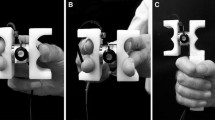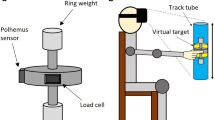Abstract
The experiment examined the force fluctuations during two and three digit grip configurations to investigate the relationship between task performance and inter-digit individuation as a function of force level and visual information intermittency rate over ∼100-fold range (0.21–20 Hz). Subjects grasped an object with either the index finger (two digit grip) or the index and middle finger (three digit grip) opposing the thumb and produced isometric force to match a low and high total force level target. Force accuracy was lower at the large visual intermittency conditions and the higher force level. The force variability was lower in the three digit grip. Inter-digit individuation increased as a function of visual intermittency rate and was greater at the low force level. There was no improvement in performance or inter-digit individuation when visual feedback intermittency was greater than ∼6 Hz (∼150 ms). Linear regression between the measures of task performance and inter-digit individuation yielded a significant negative relationship that was only present in the two digit grip when visual feedback rate was 1.67 Hz or lower and in the three digit grip when the feedback rate was 10 Hz or lower. The greater biomechanical degrees of freedom in the three digit grip configuration enable the subject to use, more effectively, visual information feedback at faster timescales in maximizing task performance by increasing digit independence. The shift from visual to nonvisual dominated motor control processes is dependent on the interaction of informational and biomechanical degrees of freedom.








Similar content being viewed by others
References
Baud-Bovy G, Soechting JF (2001) Two virtual fingers in the control of the tripod grasp. J Neurophysiol 86:604–615
Christou EA, Grossman M, Carlton LG (2002) Modeling variability of force during isometric contractions of the quadriceps femoris. J Mot Behav 34:67–81
Desmurget M, Grafton S (2000) Forward modeling allows feedback control for fast reaching movements. Tr Cog Sci 4:423–431
Jan HJ, Downing JH (2001) Effects of aging, grip span and grip style on hand strength. Res Q Ex Sport 72:71–77
Johansson RS, Westling G (1984) Roles of glabrous skin receptors and sensorimotor memory in automatic control of precision grip when lifting rougher or more slippery objects. Exp Brain Res 56:550–564
Jones LA (2000) Visual and haptic feedback in the control of force. Exp Brain Res 130:269–272
Jordan K, Newell KM (2004) Task goal and grip force dynamics. Exp Brain Res 156:451–457
Jordan K, Pataky TC, Newell KM (2005) Grip width and the organization of force output. J Mot Behav 37:265–294
Li Z-M, Latash ML, Zatsiorsky VM (1998) Force sharing among fingers as a model of the redundancy problem. Exp Brain Res 122:71–78
MacKenzie CL, Iberall T (1994) The grasping hand. The Mathworks, Inc Matlab (Version v61) Amsterdam, North Holland Natick
Miall RC, Wolpert DM (1996) Forward models for physiological motor control. Neur Netw 9:1265–1279
Myers LJ, Suresh N (2004) Thre relationship between EMG–EMG coherence and variability of force production during precision grip. Soc Neurosci Abstracts 653.7.
Newell KM, (1986) Constraints on the development of coordination. In: MG Wade, HTA Whiting (eds) Motor development in children: aspects of coordination and control. Martinus Nijhoff, Dordecht, The Netherlands, pp 341–360
Newell KM, Corcos DM (1993) Variability and motor control. Human Kinetics, Champaign
Newell KM, McDonald PV (1994) Information, coordination and the control in a prehensile force task. Hum Mov Sci 13:375–391
Pincus SM (1991) Approximate entropy as a measure of system complexity. Proc Nat Acad Sci 88:2297–2301
Pincus SM, Singer BH (1996) Randomness and degrees of regularity. Proc Nat Acad Sci 93:2083–2088
Rearick MP, Casares A, Santello M (2003) Task-dependent modulation of multi-digit force coordination patterns. J Neurophysiol 89:1317–1326
Scheiber MH (1991) Individual finger movements of Rhesus monkeys: a means of quantifying the independence of digits. J Neurophysiol 65:1381–1391
Schieber MH, Santello M (2004) Hand function: peripheral and central constraints on performance. J Appl Physiol 96:2293–2300
Sharp WE, Newell KM (2000) Coordination of grip configurations as a function of force output. J Mot Behav 32:78–82
Slifkin AB, Newell KM (1999) Noise, information transmission and force variability. J Exp Psych Hum Percep Perf 25:837–851
Slifkin AB, Vaillancourt DE, Newell KM (2000) Intermittency in the control of continuous force production. J Neurophysiol 84:1708–1718
Sosnoff JJ, Newell KM (2005) Intermittent visual information and the multiple timescales of visual motor control of continuous isometric force production. Percept and Psychophysic 67:335–344
Vaillancourt DE, Russell DM (2002) Temporal capacity of short-term visuomotor memory in continuous force production. Exp Brain Res 145:275–85
Vaillancourt DE, Slifkin AB, Newell KM (2002) Inter-digit individuation and force variability in the precision grip of young, elderly and Parkinson’s disease participants. Mot Control 6:113–126
Vaillancourt DE, Thulborn KR, Corcos DM (2003) Neural basis for the processes that underlie visually guided and internally guided force control in humans. J Neurophysiol 90:3330–3340
Author information
Authors and Affiliations
Corresponding author
Rights and permissions
About this article
Cite this article
Sosnoff, J.J., Jordan, K. & Newell, K.M. Information and force level interact in regulating force output during two and three digit grip configurations. Exp Brain Res 167, 76–85 (2005). https://doi.org/10.1007/s00221-005-0009-y
Received:
Accepted:
Published:
Issue Date:
DOI: https://doi.org/10.1007/s00221-005-0009-y




